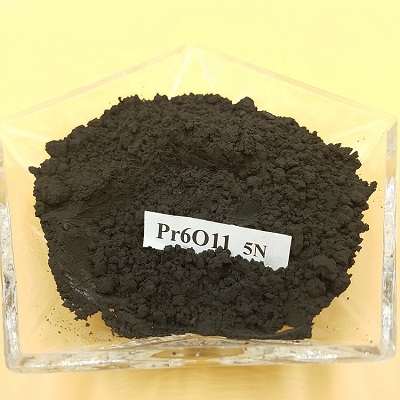| Identification | More | [Name]
Praseodymium oxide | [CAS]
12037-29-5 | [Synonyms]
PRAESEODYMIUM (III,IV) OXIDE
PRASEODYMIUM(+3,+4)OXIDE
PRASEODYMIUM(III,IV) OXIDE
PRASEODYMIUM(III) OXIDE
PRASEODYMIUM OXIDE
PRASEODYMIUM OXIDE BROWN
PRASEODYMIUM OXIDE GREEN
PRASEODYMIUM OXIDE(III,IV)
hexapraseodymiumundecaoxide
praseodymiumoxide(pr6o11)
praseodymiumundecaoxide
PRASEODIMIUM OXIDE
Praseodymium(III
PRASEODYMIUM(III,IV) OXIDE, 99.999%
PRASEODYMIUM(III, IV) OXIDE, NANOPOWDER, <100NM (BET), 99%
PRASEODYMIUM(III,IV) OXIDE, 99.9%
PraseodymiumOxideGr99.9%
Praseodymium(III,IV) oxide, 99.90%
PRASEODYMIUM OXIDE NANO-DISPERSION
PRASEODYMIUM OXIDE, 99.9% | [EINECS(EC#)]
234-857-9 | [Molecular Formula]
O3Pr2 | [MDL Number]
MFCD00011178 | [Molecular Weight]
329.81 | [MOL File]
12037-29-5.mol |
| Chemical Properties | Back Directory | [Appearance]
dark green to dark brown or black powder | [Melting point ]
2500°C | [density ]
6.5 g/mL at 25 °C(lit.)
| [storage temp. ]
Inert atmosphere,2-8°C | [form ]
nanopowder
| [color ]
Dark green to dark brown or black | [Water Solubility ]
insoluble | [InChI]
InChI=1S/3O.2Pr/q3*-2;2*+3 | [InChIKey]
MMKQUGHLEMYQSG-UHFFFAOYSA-N | [SMILES]
[Pr+3].[Pr+3].[O-2].[O-2].[O-2] | [Uses]
Glass and ceramic pigment, laboratory reagent.
| [CAS DataBase Reference]
12037-29-5(CAS DataBase Reference) | [EPA Substance Registry System]
12037-29-5(EPA Substance) |
| Safety Data | Back Directory | [Hazard Codes ]
Xi | [Risk Statements ]
R36/37/38:Irritating to eyes, respiratory system and skin . | [Safety Statements ]
S26:In case of contact with eyes, rinse immediately with plenty of water and seek medical advice .
S37/39:Wear suitable gloves and eye/face protection . | [WGK Germany ]
1
| [RTECS ]
TU1480000
| [TSCA ]
Yes | [HS Code ]
28469017 | [Toxicity]
rat,LD50,oral,> 5gm/kg (5000mg/kg),Acute Toxicity Data. Journal of the American College of Toxicology, Part B. Vol. 12, Pg. 626, 1993. |
| Hazard Information | Back Directory | [Description]
Praseodymium Oxide, or praseodymia, is a dark brown powder that is insoluble in water and only in strong acids. Praseodymium Oxide is stable under average temperatures and pressures. Praseodymium Oxide is a rare earth oxide compound, which is a basic anhydride and can react with acids and with potent reducing agents in redox reactions. Rare earth oxide compounds contain at least one oxygen anion and one metallic cation. They are typically insoluble in aqueous solutions (water) and extremely stable, which makes them useful in ceramic structures. For this reason, Praseodymium Oxide has a wide range of applications, from producing clay bowls to advanced electronics. Praseodymium Oxide is also valuable for lightweight structural components in aerospace and electrochemical applications such as fuel cells due to its ionic conductivity.
| [Chemical Properties]
dark green to dark brown or black powder.
Praseodymium oxide is a weak coloring oxide that melts at (1710°F)932°C. One of the lanthanide oxides, praseodymium is classified in the periodic table as a rare earth oxide. It's not used extensively in ceramics but is used in yellow stains with zirconium silicate. This oxide is slightly soluble in water and is very toxic.

Praseodymium can be obtained as an oxide but it's usually introduced into a glaze recipe in the form of a commercial stain such as Mason 6433,6405, or 6407.
| [Application]
Praseodymium oxide nanoparticle is widely used in magnetic materials. It has also applications in catalysis. | [Production Methods]
1. Monazite concentrates go through the alkali solution, phosphorus moving out, leaching of diluted hydrochloric acid to get the rare earth chloride solvent;
2. Next, extract with P2O4-kerosene-HCl-ReCl system to divide it into three groups, which are light, middle, and heavy rare earth;
3. Then raffinate La-Nd light rare earth is divided according to the oxalate sediment sequence, which is samarium-neodymium(Nd)-praseodymium-cerium-lanthanum;
4. oxalate sediment could produce a soluble complex and then separate and dry to get the Praseodymium oxide(Pr6O11) at 1000℃.
Chemical equation: 3Pr2(C2O4)3→Pr6O11+7CO2+11CO.
| [Flammability and Explosibility]
Nonflammable | [reaction suitability]
reagent type: catalyst
core: praseodymium | [Purification Methods]
Dissolve the oxide in acid (perchloric acid), precipitate it as the oxalate and the salt is ignited at 650o to give the oxide. | [Toxics Screening Level]
Due to a lack of available toxicity data by the inhalation route of exposure, the ITSL for praseodymium oxide is being set at the default value of 0.1 μg/m3 with annual averaging. |
|
|